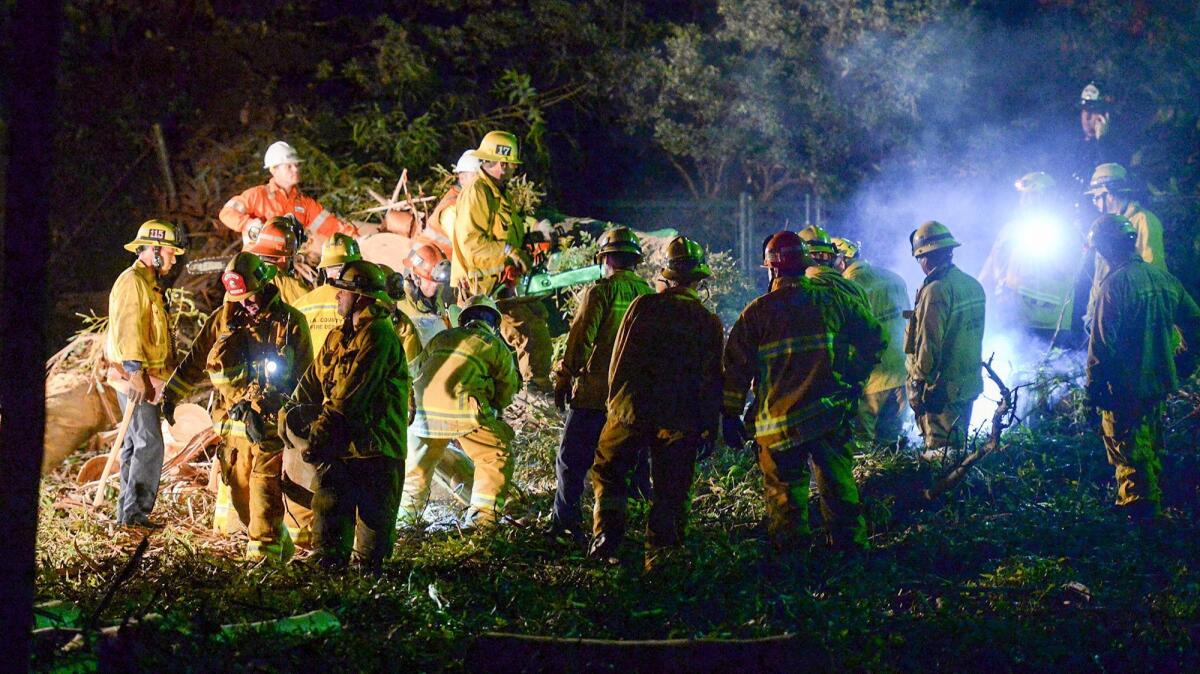Expert: Doubtful that drought felled eucalyptus tree at Whittier wedding party

- Share via
Whittier city officials have tapped a third-party arborist to inspect the trees in Penn Park, where an 80-foot eucalyptus toppled onto a wedding party Saturday afternoon, killing the mother of the bride.
The victim was identified as Margarita Mojarro, 61, of San Pedro, a coroner official said. The family identified her as the mother of the bride, according to KABC-TV Channel 7.
According to state data and Los Angeles-based expert Ruben Green, who runs Evergreen Arborists Consultants, eucalyptus trees are the third-most common failing tree in California, though there are still relatively few incidents compared with the millions of trees across the state.
What types of tree usually fall?
Failing trees aren’t usual considering the countless trees in California’s cities, parks and forests. That said, there have been 5,902 tree or tree branch “fails” since 2010 in California, according to the University of California’s Tree Failure Report Program.
Of those, 23.2% involved oak trees, 17.1% were pine trees and 12.6% were eucalyptus.
Did the eucalyptus that fell Saturday fit the typical profile?
Yes. According to a 2014 report from The Britton Fund, a nonprofit entity from the International Society of Arboriculture’s Western Chapter, the average age and size of failing eucalyptus in California is 65 years old and 81 feet tall.
Saturday’s tree was an 80-foot-tall eucalyptus that was at least 50 years old and had a trunk diameter between 6 and 8 feet, Los Angeles County firefighters said.
Two-thirds of trees that failed were in high-use areas like Penn Park’s eucalyptus, and 58% of them occurred in the winter months between November and February, the report stated.
The most common defect among the trees in the report were heavy lateral limbs, which were too big for the tree’s root system and trunk to support.

The mother of the bride was reportedly killed. A 4-year-old girl was badly hurt.
Could it have fallen because of the drought?
According to Green, that’s not likely. The park appears irrigated and there hasn’t been a reported spike in tree failings since California’s drought took hold five years ago.
Two factors that can cause a tree to fail, however, are long-term effects of decay and short-term effects of rain on loosening soil.
Do we know if this tree fell because of decay or rain?
It’s too early to tell.
If the trunk snapped apart from its “root plate” below ground, Green said, that would be a symptom of long-term decay to the roots until they were so compromised that they were too weak for the tree.
If they remained attached and the entire tree fell over, unearthing all of its roots and the soil that were holding them, that would be a sign that it was the soil that failed, not the tree itself, he said.
Sometimes only part of the roots are compromised and others are not, further muddying the investigation for arborists, he said.
Could the city have detected the tree would fail?
It depends on the cause.
Whittier maintains a pruning and inspection schedule for its trees, though officials wouldn’t immediately say what that was and when the last time Saturday’s tree had been inspected.
But typically trees in municipalities are inspected on a one- to five-year basis, Green said. Long-term issues like root decay would be detectable because the tree would show outward symptoms like mushrooms growing around its base or on its trunk, he said.
“By the time you have a mushroom you have advanced decay – that means the wood has been eaten up,” Green said. “The structural integrity…is like mush, like soft bread. It takes years for this to happen.”
Another sign of decay would be a callous, or a raised ring on the bark that forms around an infected area on the tree’s surface.
Conversely, a green canopy isn’t a sign of a tree’s health, Green said.
“A tree canopy can still be green but that doesn’t mean the root system is structurally sound,” he said.
But if the tree itself was healthy and it was the ground around it that was failing, that’s difficult to predict, Green said. Heavy branches saturated with water and a powerful wind gust has been known to knock over a healthy eucalyptus, he said.
“Those are hard to detect,” Green said. “I don’t know how you would do it unless you see the soil shifting…you can’t detect it.”
Where does eucalyptus come from?
They are originally from Tasmania and Australia and were introduced to California in the 1800s. They were used as windbreaks and for their timber but have since become naturalized across California.
For breaking California news, follow @JosephSerna on Twitter.
ALSO
Attorneys deliver closing arguments in Lee Baca’s obstruction of justice trial
Judicial panel clears California judge who gave lenient sentence in Stanford sexual assault
Tired truck driver blamed for 2015 Metrolink derailment near Oxnard that killed 1 and injured dozens
More to Read
Sign up for Essential California
The most important California stories and recommendations in your inbox every morning.
You may occasionally receive promotional content from the Los Angeles Times.














